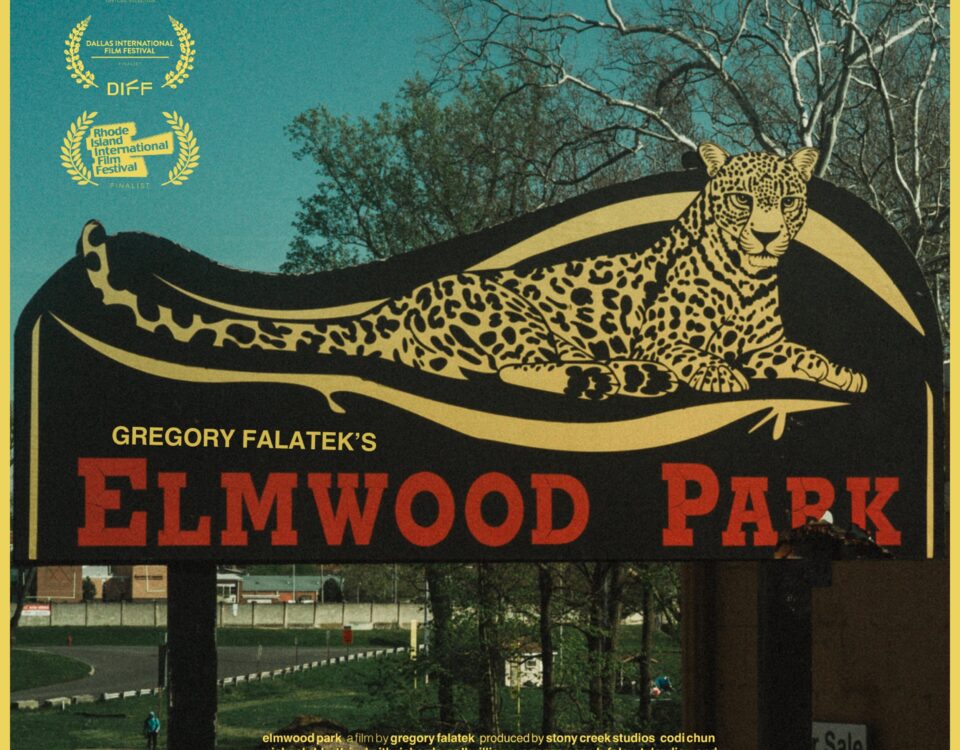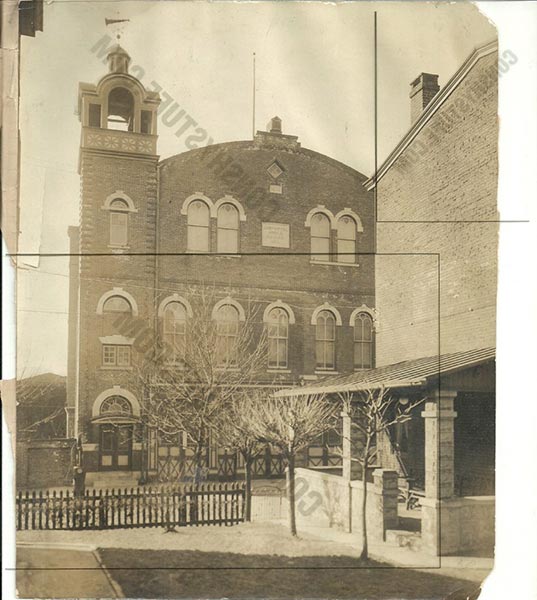
Looking Back in VIDEO, of the Conshohockens.
August 4, 2022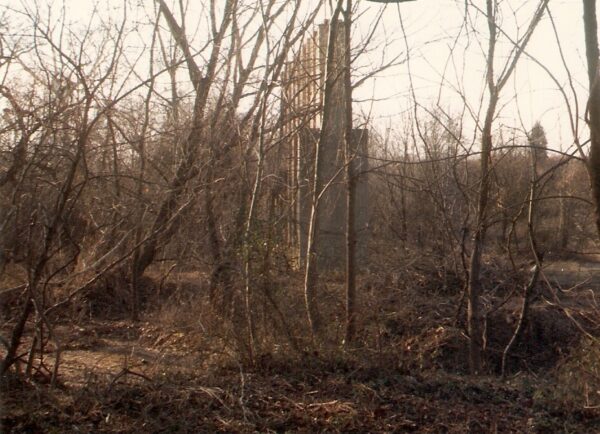
Summertime Memories in Conshohocken
August 8, 2022A Century Ago
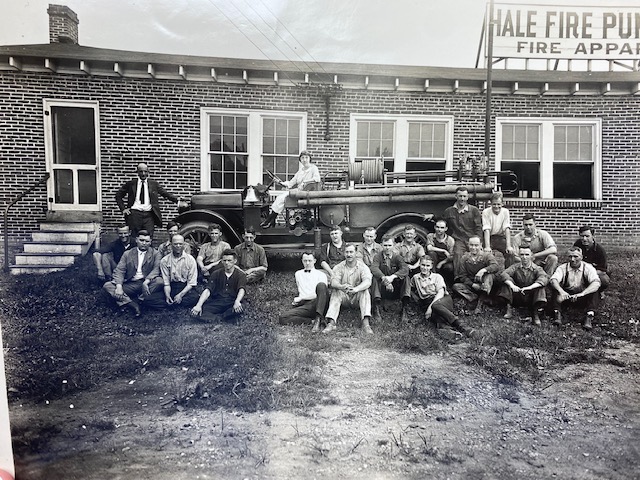
Looking Back 100 Years
It’s Pretty Fascinating
By Jack Coll
July 20, 2022 (Published August 7th)
**** If you are reading this on August 7th, please join us at Conshy Night in Reading to watch the R-Phils play at 5:15. FREE tickets outside of Coll’s Custom Framing today
I’m sitting in my third-floor office on a hot summer night not thinking about anything in particular when my mind drifts off and I start thinking about life in Conshohocken a hundred years ago. Of course, I thought about how different things were back in 1922 so I sprung out of my chair, (I didn’t really spring out of my chair, I just celebrated a birthday and realized that I don’t spring out of nowhere anymore) but I went to my files and pulled out the year 1922, of course I didn’t find anything new and exciting but thought you might enjoy a ride back in time to 1922 when the nation and Conshohocken lived an easier simpler life.
Let’s see what was going on in Conshohocken in 1922, well you could purchase a new house for around $5,000, and yes that was pretty expensive considering you had to Pony-up about $15.00 a month for the mortgage payment. A 1922 brand-new automobile from Moore Car Agency located at Twelfth Avenue and Fayette Street would set you back just under $400.00 but keep in mind that gas was 10 cents a gallon. (Moore opened his automobile dealership at Twelfth Avenue and Fayette Street in 1915)
Very few Conshohocken residents could even consider sending their child to Harvard University at a tuition rate of $250.00 per year but mailing a postcard was still pretty cheap at two cents per stamp.
Food at the corner stores would also cost you and there were a lot of corner stores in both Conshohocken and West Conshohocken back then, check-out these prices, a 15-pound sack of sugar was $1.00, Ground Coffee was 15 cents a pound, eggs were 12 cents per dozen, hamburger was 13 cents per-pound and a freshly baked loaf of Bread was 9 cents.
The Riant Theatre was only open for a few months having opened on November 11, 1921 but throughout the 1922-year movies like “The Return of Grey Wolf,” “Robin Hood,” “Down to the Sea in Ships” and “The Married Flapper” were hit movies of the year, they were all silent movies but still good movies. Of course, the tickets at the Riant Theatre would set you back between 7 and 15 cents depending on when you attended. Just think of all the things you had to support on the average income of just under $2,000. Per year. Back in 1922 a hundred bucks translates to $1,645.45 today. And by the way, “Robin Hood” was the number one movie of the year. Douglas Fairbanks and Wallace Beery starred in this silent adventure film.

Music from 1922, I’m always interested in music, but I must admit I don’t remember any of these classics including “Ma! He’s Making Eyes At Me” by Olive Fox, “Dill Pickles Rag” by William Reitz, “Aunt Hagar’s Children Blues,” by W. C. Handy, and “You Were Meant for Me,” by Eubie Blake. The number one hit song of 1922 was “My Man,” by Fanny Brice.
Let’s take a minute and check-out a few national figures. Men had a life expectancy of 58.4 years, and women lived an average of 61 years. In August of 1921, the Roaring Twenties began. The nation’s wealth more than doubled between 1920 and 1929, bringing widespread prosperity to the U.S.
In 1922, about 12.2 million motor vehicles were registered in the U.S. Today, we have over 289.5 million vehicles on the road. The price of a Model T Ford was lowered to $319. Ford manufactured over 1.3 million of these cars in 1922.
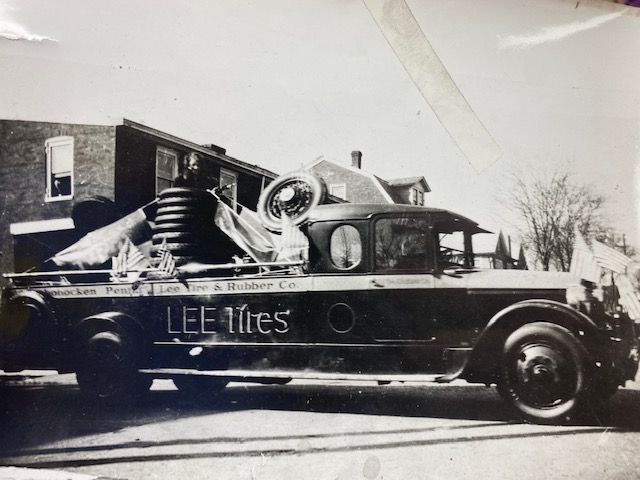
And how about this! In 1922, 40 percent of the homes in America had electricity. Most of rural America would remain without electricity until the mid 1930’s. About 35 percent of the houses had a telephone.
I found this interesting! On January 11, 1922, 14-year-old Leonard Thompson became the first person to receive an insulin injection for treatment of diabetes. Insulin was discovered, in July 1921, by Canadian scientists Frederick Banting and Charles Best.
On October 22, 1922, Amelia Earhart flew her Kinner Airster to over 14,000 feet and set the altitude record for female pilots. The Hollywood Bowl officially opened on July 11, 1922, with a performance by conductor Alfred Hertz and the Los Angeles Philharmonic. Thank goodness for Christian Kent Nelson who on January 24, 1922, he patented the “Eskimo Pie.” It was America’s first chocolate-covered ice cream bar. In 1922, only 16.8 percent of students graduated from high school.

In 1922 the first Thom McCann Shoe Store opened in New York City, on October 14. They would go on to become the nation’s largest shoe retailer from the 1960’s to the 1980’s. The brand is still being sold a hundred years later and can be found in K-Mart and Sears stores.
And one final note, THANK YOU WALGREENS, in the summer of 1922 Walgreens introduced the malted milkshake.
The 1920’s were an exciting time in America, throughout the 1920’s Americans were dancing “The Charleston”, women were able to vote, and the Lincoln Memorial was dedicated on May 30, in Washington D.C.
Warren Harding was President of the United States, Vice President was Calvin Coolidge. Beauty contests were all the rage including the Miss America Pageant, which by the way banned seductive bathing suits in 1922.
A few celebrities you might remember were born in 1922 including Betty White, Carl Reiner, Jack Klugman, Sid Caesar, Paul Scofield, Redd Foxx, Shelley Winters, Judy Garland and a fellow named Charles Schulz, in 1950 Charles created a comic strip tentatively titled “Li’l Folks.” The strip was accepted for syndication under the new title “PEANUTS” and became the most successful cartoon strip in history.
And let’s not forget two of my favorite actors born in 1922, Doris Day, no-explanation needed and a guy named Darren McGavin, he of course played the “Old Man” in “Christmas Story.”
Okay, I have a file from 1922 on Conshohocken, let’s see if we can find a few interesting tid-bits about our town from a hundred years ago. Well, this is kinda interesting, you don’t see this every June! The Conshohocken Recorder newspaper ran a small article on June 23, 1922 stating that Ruth Viola Shimer, a member of the graduating class of the West Conshohocken High School was not present at the commencement held at Odd Fellows Hall to receive her diploma and the essay to have been delivered by her was omitted from the program.
Ruth appeared at the Montgomery County Court House in Norristown the night of graduation with Charles M. Krout of Frederick, Maryland and procured a marriage license. The article stated that Ruth was the daughter of Harry Shimer, of Crawford Hill, West Conshohocken, her mother had passed away several years earlier. So, here’s the story that the newspaper reported, Ruth, who was eighteen years old visited her aunt, who resided on the Conshohocken Pike, (Upper Fayette Street) near North Lane while the carnival was in operation on the Tracey estate a few weeks earlier and at the fair met Charles Krout, who was in charge of the ponies at the carnival and which was stabled at her aunt’s place.
It was a case of love at first site and Ruth persisted in remaining away from home and also refused to take part in any class rehearsals for the commencement. No information regarding the wedding could be secured from members of the Shimer family other than that the wedding had taken place.
Looking back a hundred years you realize that Charles and Ruth’s lives have come and gone and we can only hope the couple that was so young and so in love had themselves a great life.
It was interesting to note that in that same year that three diplomas were awarded to students from St. Gertrude’s School in West Conshohocken. The event was celebrated with a High Mass celebrated by the rector Rev. Thomas Gaffney. The graduating students included Thomas Kelly, John McGuire and Gerald McGuire. Awards for meritorious attendance were awarded to Thomas Kelly, Catherine Murphy and Agnes Carlin. Also, interesting to note that neighboring Upper Merion Township graduated 21 high school students.
And, while we’re on the topic of graduating students in 1922, Conshohocken High School celebrated their 51st Annual Commencement with the largest graduating class in the school history passing out 37 Diploma’s. There were some familiar family names in the graduating class including Rosella Gravenise, Olglinn Kriebel, Dorothy Ramsey, Rose Kauffman, Genevieve Millhouse, Nellie Horn, Charles Pettine, Harold Frankenfield, Raymond Freas, Glen Davies, Paul Righter, and Howard Hastings among others, perhaps a few of our readers might remember one or two of these graduates as Grand-ma or Grand-pa!
St. Matthew’s High School, still located on East Hector Street back then, the new grade school wasn’t built until 1929 on Fayette Street, graduated 14 students in 1922, seven boys and seven girls. Of course, some very familiar St. Matthew’s names were among the graduates including Helen Botto, Margaret Collins, Alice Mary O’Brien, Frances Rafferty, Paul Dugan, Arthur Gavin, Horace Kriebel, Edmund Mellon and Thomas O’Brien among others.
It’s interesting that Whitemarsh Schools listed that 31 students participated in commencement exercises from their various schools. A few of the names mentioned included Dorothy Freas, Ester Cressman, Ruth Staley, Dorothy Rodenbaugh, Wilbur Wentz, Florence Crawford, George Lentz, Robert Ramsey, Helen Potts and Sydney Yerkes among others.
And let’s not forget West Conshohocken’s ten graduates. It was the largest graduated class from the school since 1892. Their festive ceremonies were held in the Odd Fellows Hall once located on Ford Street.

In other news around town in 1922, it seemed as though the Conshohocken Chamber of Commerce was pushing for the creation of a public swimming pool. Mr. Kearns, chairman of the special committee appointed to investigate conditions surrounding the location of a possible site for a public swimming pool reported that the old quarry hole in the rear of Second Avenue could be put in proper shape by building a dam to make a good-sized swimming pool. An engineer of the Lee Tire Company had estimated that the cost of the dam at Plymouth Creek and necessary filing-in and other amenities would cost around $2,000. (The pool was never established at the creek)
It was a big story in the January 24, edition of the Conshohocken Recorder newspaper when it reported that a well-known grocer Patrick J. Leary had passed away. Mr. Leary was a life-long resident of the borough and first opened a grocery business with Charles Willimann on West Elm Street near Forrest Street. Mr. Leary later purchased the property at 37 Fayette Street where he continued serving the community. He later purchased a property at Fayette and Marble Streets from the O’Brian family. Mr. Leary lived at 215 Spring Mill Avenue.
If the Leary name sounds familiar, he left behind three children Joseph, Marie and Rosalie, many living residents may recall all three children as Joseph went on to have a successful dental business at 201 Harry Street for many years.
Perhaps we should mention a few of the businesses from a hundred years ago in Conshohocken. Well, there was Kessler’s Shoe Store once located at 40 Fayette Street, looks like baby shoes, black or white top were selling for $1.29 a pair and Boy’s oxfords were selling for $2.50.
“HEADQUARTERS FOR EASTER GOODS OF ALL KINDS” was the add for J. N. Pedrick’s candy store once located at 527 Fayette Street. If you needed a pair of roller skates in 1922, Gabin’s, “The Store of Better Service” was selling them at the corner of Fayette and Elm Streets for one dollar a pair, “THAT’S ONE DOLLAR’

At Darrar’s Boot Shop once located at 41 Fayette Street they advertised “Endicott-Johnson’s shoes for men,” “Better Shoes for less money.” Paul Carroll was a pharmacist for many years at 102 Ford Street in West Conshohocken, back in the good old days when druggist actually mixed their own drugs, opium, morphine and cocaine were often in the mix of chemicals to help cure any and all aliments.
A Grand Announcement in the Recorder newspaper, dated January 6, 1922 that SMITH’S AUTO SHOP was celebrating a Grand Opening. Charles Smith opened his automobile accessories store at 13 East First Avenue.

It was a “One Cent Sale” at Conshohocken Candyland once located at 59 Fayette Street. Assorted fruits and nuts, 74 cents a pound, two pounds for 75 cents, Assorted broken candy 40 cents a pound, 41 cents for two pounds. Peanut Fudge, 30 cents a pound and two pounds for only 31 cents a pound and Coconut Kisses also were 40 cents a pound or two pounds for 41 cents a pound.
Well, here’s a few business tid-bits from 1922, T. J. Carroll’s undertaking business was moving from 205 East Hector Street to 1100 Fayette Street, you could call Mr. Carroll at 505-W. It was announced that a new Great Atlantic & Pacific Tea Company, (A&P Grocery Store) that was currently operating at 75 Fayette Street was opening a new store at Sixth Avenue and Wells Street. William Geiger was retiring from business after many years of running his grocery and feed store at Fifth Avenue and Wells Street, he lived at 230 East Seventh Avenue for many years. If you needed a carpenter for any job, you could call William Moore at 306-J, Moore ran his business from his home at 107 West Fourth Avenue. If you needed groceries, you could call Ernest Famous at 248, his place of business was on West Sixth Avenue.

Many of the long-time residents would remember Jacobson’s Department Store located for many years at 69 Fayette Street. Jacobson’s sold everything from clothes, to umbrellas, hats and hand bags. William H. Ray, a well-known Jeweler for many years was located on the corner of Hector and Fayette Street and was known for his fine watch making. You could pick-up a 14-karat gold open face man’s watch for $18.50 and up, a top-of-the-line ladies watch for just 12.50 and up.
Is it possible that the most exciting thing happening in Conshohocken and throughout the country during the 1920’s was prohibition, many citizens at the time would say YES! Perhaps a quick history lesson on the 18th Amendment for our younger readers would be in-order, SO. Women throughout the country, notably the Women’s Christian Temperance Union, including the Conshohocken Chapter, who had their headquarters at Third Avenue and Harry Street in this borough, (The building still stands today) cried-out to local and National leaders for a national prohibition in the United States. They believed it would protect families, women and children from the effects of alcohol abuse.
In 1919, legislatures around the Country ratified the 18th Amendment to the Federal Constitution, enabling National Prohibition within one year of ratification. On January 16, 1920, the 18th Amendment went into effect, and with that, thousands of prohibition agents were sworn in to up hold the law. As a result, a war like no other in the United States of America played out in every major city, township and borough, from sea to shining sea for the next 13 years.
I could actually write a small book on the goings-on in Conshohocken and West Conshohocken on prohibition and illegal gambling from the years 1920-1933, and a whole lot of our grandparents would show up as subjects in the book.
In Conshohocken and West Conshohocken, “Speakeasies” and other underground drinking establishments flourished throughout the boroughs. There were hundreds of private drinking bars, all of them at the time were illegal. It was reported that on Saturday nights, Ford Street and Front Street in West Conshohocken looked like a tourist town with all the visitors coming and going to purchase “Moonshine.” In Conshohocken, Hector Street, Elm Street, lower Maple Street and all of Connaughtown seemed to have more visitors than residents seen carrying bottles of “Hootch” from what seemed like every other house in the community.

Over the 13-year period of prohibition hundreds of local and federal raids were conducted in the two boroughs’ but I have to tell you that it didn’t seem to discourage residents from participating in the Moonshine and Sunshine business. The Feds made the distinction between Moonshine and Sunshine pertaining to the fact that Moonshine was typically made outdoors, at night primarily in a wooded area by the light of the moon. Sunshine was said to have been made during the daytime pointing to the fact that many housewives were caught making hootch in the family bathtub after their husbands had gone to work in the morning. (I believe that hootch was being mixed with the husband’s permission so it was ready for sale by the time he arrived home from work, just-sayin)
1922, a hundred years ago, times were certainly different, as expected. Trolley cars were clanging along Fayette and Hector Streets, the trolleys ran in Conshohocken from 1893-1933, for 40-years trolleys were the main means of transportation for borough residents. On September 9, 1933 the trolleys ceased operating and buses became the main means of transportation in both boroughs. Most of the roads in both boroughs were still unpaved in 1922, we didn’t have trash collection and the streets didn’t get plowed when it snowed. There were no traffic lights on Fayette Street or any other streets in the borough. Without taking time to get out of my chair to confirm but I think the first traffic light in the borough came in 1926, and was installed at Fayette and Hector Streets.
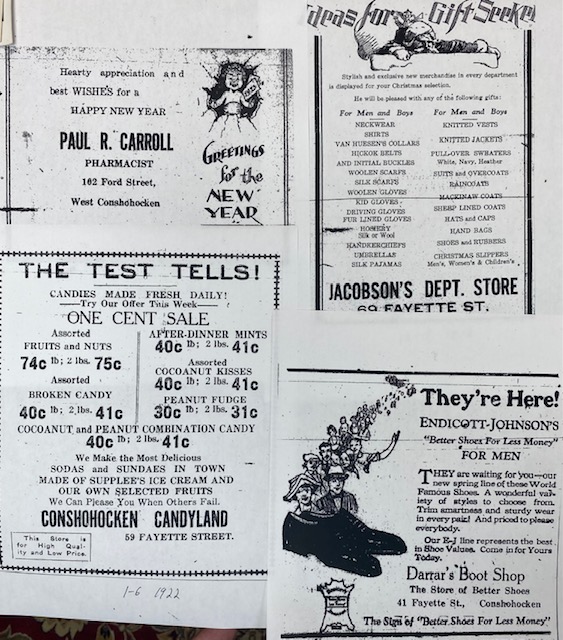
By 1922 Conshohocken had continued to grow each and every year since its incorporation in 1850. When the borough was incorporated on May 15, 1850 there were 727 residents occupying the lower part of the borough at that time, the upper portion of the borough’s land was undeveloped. In 1922, seventy-two years later the boroughs population had grown to nearly 9,000 residents. Interesting to note that our population at that time showed that the male and female population were nearly equal, with approximately 3,500 of our residents being children under the age of 21.
It was Conshohocken’s industry boom at the turn of the century that brought in thousands of residents, many of them being immigrants, with opportunities for employment at the borough’s many places of employment. A quick check of some of companies that provided employment back then were as follows:
Philip Carey Manufacturing Company—Est. 1902
C. & D. Batteries—Est. 1912
G. & W. H. Corson Inc.—Est. 1832
Wm. Davis Jr. & Co.—Est 1850
Ford & Kendig—Est.1879
Foundry Manganese—Est. 1912
Francis L. Freas Glass Works—Est. 1905
Hale Fire Pump—Est. 1914
W. C. Hamilton & Sons—Est. 1856
Kimble Glass Co.—Est. 1910
E. J. Lavino & Co.—Est. 1916
Lee Rubber & Tire Co.—Est. 1910
Lee Surgical Supply Co.—Est.1887
Merion Worsted Mill—Est. 1891
Philadelphia Uniform Co.—Est. 1903
Quaker Chemical Products Corp.—Est. 1918
Schuylkill Iron Works—Est. 1870
The H. C. Jones Co.—Est. 1880
Howard W. Vandergrift Co.—Est. 1922
Alan Wood Steel Co.—Est. 1832
John Wood Manufacturing Co.—Est. 1867
And there were a number of other smaller companies that opened their doors for employment opportunities. With increasing population, it also brought opportunities for family-owned business, some mentioned above. How many family businesses? Well according to the 1930 census there were 240 retail outlets and services being offered, most of them from Second Avenue down to the bridge and along the streets of Elm, Hector and First Avenue.
The roaring Twenties nation-wide showed well dressed citizens doing the Charleston dance at speakeasies during their evenings. In Conshohocken there was a whole different kind of roaring twenties going on, good and bad. The Conshohocken Recorder Newspaper recorded the 1920’s in Conshohocken and West Conshohocken on the front pages and beyond in every issue that was being printed twice a week back then.

I see the 1920’s in Conshohocken, as in all the decades leading up to now, as the residents responsible for making Conshohocken what it is today. I see factory workers, our ancestors, who put-it on the line every day for their families and I see borough leaders who had the vision for a great future for this one square mile town.
I love the fact that young families continue to arrive in this community to join us and I can only hope that they too will take great pride in the community that they chose to live in, Welcome.

And that is a brief, a very brief look back a century ago. It wasn’t always easy back then, but the early residents, many who didn’t even speak English when they arrived in Conshohocken, worked hard and were proud Americans who also saw the future of this borough, and the future is a beautiful thing for my grandchildren and the many grandchildren who will have a future here.
My wife Donna and I have traveled throughout this country of ours on a number of occasions and I’m proud to take the Conshohocken name with me.
See-ya next time. For more historical articles and other informative articles on Conshohocken visit our Conshystuff.com website and please continue to support our small businesses and advertisers who are all based in the Conshohocken area.
PHOTOGRAPHS AND OTHER IMAGES ABOVE INCLUDE:
An early photograph of Merion Furnace in West Conshohocken taken in 1866
George John was driving the Lee Tire & Rubber Company car back in 1920. If you look close enough, you’ll see a women’s head what seems to be sticking out of the pile of tires on the truck, on the back of the photo it was stated that this was Mrs. Horace Wilmer, nee Mildred John, you figure it out!
A rare photograph of employees eating lunch in the Alan Wood Steel Company cafeteria circa 1920
A photograph taken on July 11, 1922, a hundred years ago was taken at the Hale Pumps plant on Spring Mill Avenue showing off their 300 gallon Pro truck and pump. The photo shows a number of employees who had worked on the truck.
And finally, a whole handful of advertisements that were taken from the 1922 Conshohocken Recorder.

